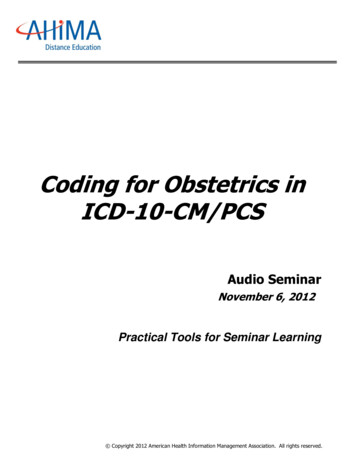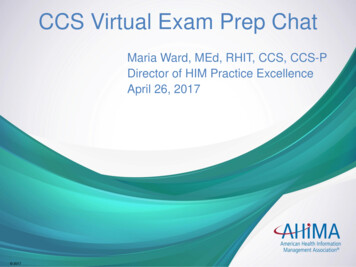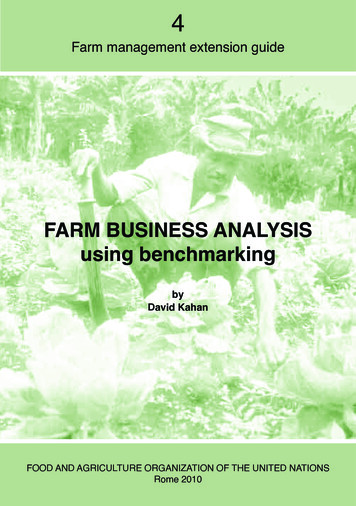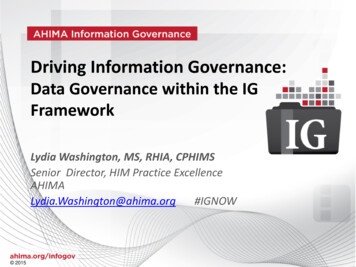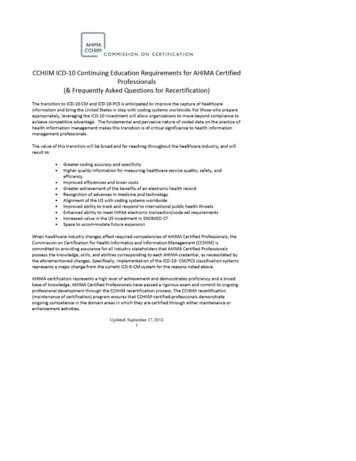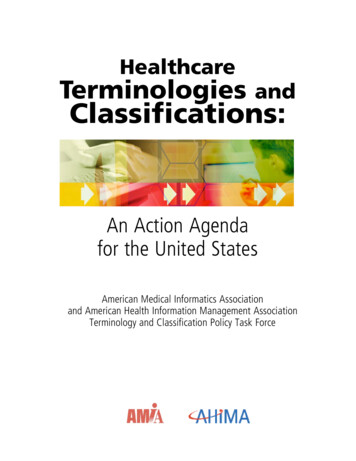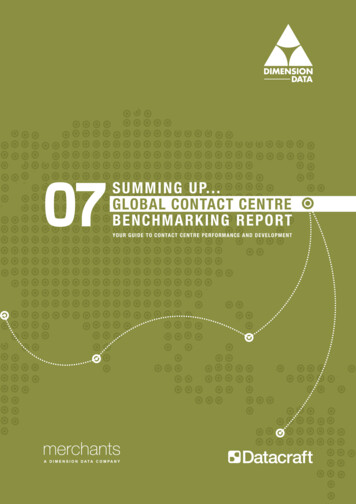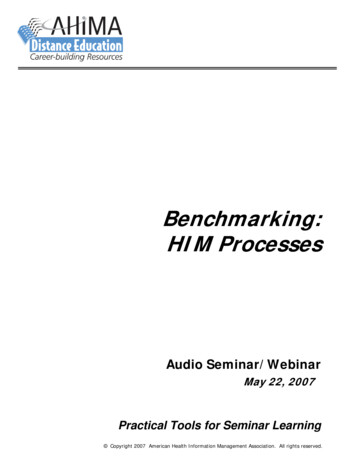
Transcription
Benchmarking:HIM ProcessesAudio Seminar/WebinarMay 22, 2007Practical Tools for Seminar Learning Copyright 2007 American Health Information Management Association. All rights reserved.
DisclaimerThe American Health Information Management Association makes norepresentation or guarantee with respect to the contents herein andspecifically disclaims any implied guarantee of suitability for any specificpurpose. AHIMA has no liability or responsibility to any person or entitywith respect to any loss or damage caused by the use of this audioseminar, including but not limited to any loss of revenue, interruption ofservice, loss of business, or indirect damages resulting from the use of thisprogram. AHIMA makes no guarantee that the use of this program willprevent differences of opinion or disputes with Medicare or other thirdparty payers as to the amount that will be paid to providers of service.As a provider of continuing education the American Health InformationManagement Association (AHIMA) must assure balance, independence,objectivity and scientific rigor in all of its endeavors. AHIMA is solelyresponsible for control of program objectives and content and the selectionof presenters. All speakers and planning committee members are expectedto disclose to the audience: (1) any significant financial interest or otherrelationships with the manufacturer(s) or provider(s) of any commercialproduct(s) or services(s) discussed in an educational presentation; (2) anysignificant financial interest or other relationship with any companiesproviding commercial support for the activity; and (3) if the presentationwill include discussion of investigational or unlabeled uses of a product.The intent of this requirement is not to prevent a speaker with commercialaffiliations from presenting, but rather to provide the participants withinformation from which they may make their own judgments.Some of the information in this presentation has been presented by Ms.Dunn at National AHIMA Conferences, State CSA Meetings, and HCPro andAHIMA Audio Seminars or published in various journals, newsletters, orbooksAHIMA 2007 Audio Seminar Seriesi
FacultyRose T. Dunn, RHIA, CPA, CHPS, FACHEMs. Dunn is a Past AHIMA President and recipient of AHIMA’s 1997 DistinguishedMember Award. She is Chief Operating Officer of St. Louis-based, First ClassSolutions, Inc., a national health information management consulting firmproviding coding compliance and operational consulting services.Rose started her career as Director of Medical Records at Barnes Hospital, a1,200-bed teaching hospital in St. Louis. She was promoted to Vice President atBarnes and was responsible for more than 1,600 employees and new businessdevelopment. After Barnes, she joined MetLife where she worked with managedcare organizations nationwide on a variety of operational, medical management,and network development issues. Rose also has served as a Chief FinancialOfficer of a dual hospital system in Illinois.Ms. Dunn is active in several professional associations including American Instituteof Certified Public Accountants, American College of Healthcare Executives,Healthcare Financial Management Association, and American Health InformationManagement Association. She holds fellowship status in HFMA, ACHE and AHIMA.She also is certified in healthcare privacy and security.She is the author of several texts including Finance Principles for the HealthInformation Manager, More with Less and Haimann’s HealthcareManagement. In addition, she has published more than 200 articles and hasmade numerous presentations across the United States on a wide variety oftopics.Rose@FirstClassSolutions.com(800) 274-1214Cheryl Doudican, RHIAMs. Doudican is the Director of Health Information Management at Mercy HealthCenter in Oklahoma City, Oklahoma. She currently serves as one of the HIM subjectmatter experts for the Sisters of Mercy Health System, which is currently in theprocess of migrating to a common information system platform. Cheryl has vastexperience in the Health Information Management field, to include various leadershipand consulting positions. Cheryl has successfully modified workflows, decreased ARdays, and successfully collaborated with departments such as Patient Accounts andMedical Staff in efforts to improve the revenue cycle process. Cheryl has successfullyeliminated all transcription outsourcing for her facility by conducting an operationalreview of transcription, evaluating payment methodologies and implementing speechrecognition.AHIMA 2007 Audio Seminar Seriesii
Table of ContentsDisclaimer . iFaculty .iiObjectives . 1Issues Impacting Productivity. 2Polling Question #1. 3Productivity Standards . 4Collecting Data. 4Polling Question #2. 5Establishing StandardsActual Data—Inpatient Analysis . 6Address Variations. 7How Many Employees Do You Need. 7Items to Consider. 8Polling Question #3.10Designing the Incentive Plan .10Unit Pay Plan .11Monitor Quality and Productivity .12Expectations and the Plan .12Transcription Case StudyPolling Question #4.13A snapshot of transcription .14Purchased New Dictation and Transcription System.14Evaluated Pay Methodologies .15Speech Editors .15A different approach to editing .16Production Gains from Speech Editing .16Polling Question #5.17What’s happened since implementing speech recognition?.17Closing Notes.18Appendices—FTE Analysis Form .19References and Resources .21Audience QuestionsAppendix.31-32A – Time Ladder AnalystB – Time LadderC – Guidelines for Transcription Service All FunctionsD – Speech Editing Agreement (New Employee)E – Speech Editing AgreementF – Speech Performance AnalysisCE Certificate InstructionsAHIMA 2007 Audio Seminar Series
Benchmarking: HIM ProcessesNotes/Comments/QuestionsObjectives Review factors that affect productivityDiscuss how to develop and monitorproductivity standards for common HIMfunctionsApply productivity standard setting forhybrid environmentsReveal how one organization improvedtranscription productivity through the useof speech recognitionDiscuss incentive plans considerations in aspeech recognition environment1Golden Rule Don’t assume that what is doneat other places is the same aswhat is done at your placeIdiosyncrasies System differences Expectation differences 2AHIMA 2007 Audio Seminar Series1
Benchmarking: HIM ProcessesNotes/Comments/QuestionsIssues Impacting Productivity Environment(workplace/space/noise/hormones) Technology (PC, access to on-linedocuments and other reports, printers) Ease of connection Skills Education andExperience3Factors Affecting Productivity Diversity makes jobs more rewardingSpecialization/Division of Labor improvesproductivity Discussed by Adam Smith in his economicsbook An Inquiry into the Nature andCauses of the Wealth of Nations (1776) 10 pin makers-doing all 18 tasks to make apin 200 pins per day 10 pin makers-each doing specializedtasks to make a pin (assembly line) 48,000 pins per day[Adam Smith]AHIMA 2007 Audio Seminar Series42
Benchmarking: HIM ProcessesNotes/Comments/QuestionsFactors AffectingProductivity Generations Boomers: 1943-1961 “live to work” Generation X: 1962-1981 “no burn out here” Millenials/Gen Y: 1982-2002 “work to live” Generational Behavior molded by: Media Pop Culture Technology Current Events Economy Diversity[Generations]5Polling Question #1Are you experiencing generationalconflict in your workplace?*1 Yes*2 No*3 Not sure6AHIMA 2007 Audio Seminar Series3
Benchmarking: HIM ProcessesNotes/Comments/QuestionsProductivity StandardsDo independent data collection Involve staff Capture data over time Averages Address peaks and valley No one person gets the hardest casesALL the time7Collecting DataKeep it simple (KISS) At least 6 weeks (3 pay periods) Ideally no holidays Disruptions/Distractions Time Ladder8AHIMA 2007 Audio Seminar Series4
Benchmarking: HIM ProcessesNotes/Comments/QuestionsCollecting Data Time Ladder Identifies productive and non-productivetime Identifies activities that could bereassigned to others Identifies distractors Exhibits A and B(Appendix of Resource Book) Blank and Annie’s9Polling Question #2What do you think your productivetime percentage is?*1*2*3*490-100%80-89%70-79%Less than 70%10AHIMA 2007 Audio Seminar Series5
Benchmarking: HIM ProcessesNotes/Comments/QuestionsEstablishing Standards Use actual dataDetermine the average production of eachemployee After eliminating timewasters/distractors Determine production by record typeUse actual productive hoursCalculate the midpoint between thehighest producer and the average of all inthe team11Actual Data-Inpatient AnalysisEmployeeTalishaKellyRichardTotalActual 6 WeekProduction1020219018005010233 h240 h237 h710 hAverage/Day/Hr8 hours35 or 4.38/hour73 or 9.1/hour61 or 7.59/hourAvg. 56 or 7.06/hrall vs. 73 or 9.1/hrhigh(56 73)/2 65 or 8/hr-Exp. Std.12AHIMA 2007 Audio Seminar Series6
Benchmarking: HIM ProcessesNotes/Comments/QuestionsAddress Variations Talisha (single mom):What’s the story Not a new employee Phone time (personal) Richard (30 y.o.): What’s the story Doing more than Talisha! Kelly: What’s the story (may beboomer or Millie) Likes to be center of attraction Stroke her and watch the records fly!13How Many Employees Do You NeedDo not assume that every hour is aproductive hour FTE analysis Slides 38-40 at end ofthis presentation 14AHIMA 2007 Audio Seminar Series7
Benchmarking: HIM ProcessesNotes/Comments/QuestionsItems to Consider Loose materials: Old or recent Chasing Drop filing or fastening in 1”/1-1.25 hours vs. 1”/2-2.25 hours Scan the puppies15Items to Consider Analysis Assembling and analyzing orjust analyzing Specializing by clinical service Where’s the printer for the deficiencysheets Just physicians or every clinician in theworld Records queued to them via workflow orhave to pull their records from the shelfor from the floorAHIMA 2007 Audio Seminar Series168
Benchmarking: HIM ProcessesNotes/Comments/QuestionsItems to Consider Release of Information Duties other than ROI? All mail; All phone calls; Receptionists Transfer charts (to them/go after them) Where is the record? Hybrid environment greatest impact Off-site Strewn throughout clinics Charging/Not Charging17Items to Consider Cancer Registry How do charts get to them?Cross training provided to analystsCoding supportWorking remotely?Team work18AHIMA 2007 Audio Seminar Series9
Benchmarking: HIM ProcessesNotes/Comments/QuestionsPolling Question #3Are your cancer registrars working remotelyand are they more productive?*1*2*3*4My staff works on site (do not workremotely)My staff work remotely andproductivity hasn’t changedMy staff work remotely andproductivity has improvedMy staff work remotely andproductivity has deteriorated19Designing the Incentive Plan Determine if the incentive will becash in paycheck or alternative Bonus timeGift certificatesGiftsEducationFish20AHIMA 2007 Audio Seminar Series10
Benchmarking: HIM ProcessesNotes/Comments/QuestionsDesigning the Incentive Plan Assess what it would cost if contractedDetermine current per unit cost excludingbenefitsSplit differenceEx:Avg. Analyst: 13.00/hr.Per Unit: 13.00/8 1.63/unitContractor: 16.00/8 2.00/unitIncentive: 1.80/unit for each record 65/day21Unit Pay Plan Assess what it would cost if contractedDetermine current per unit cost excludingbenefitsSplit differenceEx: Avg. Analyst: 13.00/hr.Tier One: 8 records/hour 1.30/unitTier Two: 9-12 records/hour 1.50/unitTier Three: 13 records/hour 1.70/unit22AHIMA 2007 Audio Seminar Series11
Benchmarking: HIM ProcessesNotes/Comments/QuestionsMonitor Quality and Productivity Spot check sample of records Listen to customers Clinicians Incomplete Areafeedback Continue to periodicallycheck productivity Adjust expectations accordingly23Expectationsand the Plan Should: Be in writing and dated Be approved by DepartmentManagement/Administration/HumanResources Include purpose of the program Specify the expectations and any caveats Errors (demerits) Specify what happens if expectations arenot met Indicate that the policy/plan can change atManagement’s discretionAHIMA 2007 Audio Seminar Series2412
Benchmarking: HIM ProcessesNotes/Comments/QuestionsTranscription Case Study25Polling Question #4Are you using speech recognition withback-end editing for HIM transcription?*1 Yes*2 No26AHIMA 2007 Audio Seminar Series13
Benchmarking: HIM ProcessesNotes/Comments/QuestionsA snapshot of transcription: Backlog of 1391 jobs@ 3862.6 minutes Outsourcing overflow(approximately 30,000/month) Transcription coworkerswere typing directly intoMeditech27Purchased New Dictation andTranscription SystemPurchased transcription softwaresystem Purchased speech recognitionproduct 28AHIMA 2007 Audio Seminar Series14
Benchmarking: HIM ProcessesNotes/Comments/QuestionsEvaluated Pay MethodologyWas receiving hourly rate plusincentive for additional minutestranscribed beyond the minimumrequired Decided to move to a straightproduction pay system (see Exhibit C Guidelines for Transcription ServicesAll Functions)29Speech Editors versusTraditional Transcription Pay Had to find approaches that would makethe transcription coworkers want to tryeditingPaid the same amount for production forboth editors and traditional transcriptioncoworkersPaid average salary for one month for allMT’s that trained on editingEditors signed an agreement that theywould after their initial 30 days of salarymatching, that they will stay on speechediting a minimum of 2 hours per day(See Exhibits D and E)AHIMA 2007 Audio Seminar Series3015
Benchmarking: HIM ProcessesNotes/Comments/QuestionsA different approach to editing Instead of using traditional MT’sin editing, the focus was placed on hiringvocational technical school transcriptiongraduates The graduates were given a typing test todetermine if they had really good grammarand spelling skills and then trained31Production Gains from Speech Editing Gains are measured in time savedwith a report; i.e., a transcriptioncoworker as an average took 5mins. to transcribe a report, withspeech editing the time is reducedto 3 mins. (See Exhibit F SpeechPerformance Analysis breakdown)32AHIMA 2007 Audio Seminar Series16
Benchmarking: HIM ProcessesNotes/Comments/QuestionsPolling Question #5For those facilities that are usingspeech recognition, what has beenyour productivity gain?*1*2*3*4*5No gain1%-20%21%-50%51%-75% 76%33What’s happened since implementingspeech recognition?After almost 2.5 million dollars overa 5 year time period was spent onoverflow transcriptionoutsourcing nothing has beenoutsourced since September, 2006 No overtime hours in transcriptionsince September, 2006 Revenue is now being generated bytranscription 34AHIMA 2007 Audio Seminar Series17
Benchmarking: HIM ProcessesNotes/Comments/QuestionsClosing NotesQuestions?35Thank youFor your attention and fortaking time out of your busyday.AHIMA 2007 Audio Seminar Series3618
Benchmarking: HIM ProcessesNotes/Comments/QuestionsAppendices37FTE Analysis FormHours authorized per week: (Deduct) Average Auth. Vacation Hrs: ( )Average Auth. Holiday Hrs: ( )Average Sick Time Hrs:( )Average Meeting Time Hrs: ( )Auth. Breaks ( min.x240) ( )Net Hours Per FTE:38AHIMA 2007 Audio Seminar Series19
Benchmarking: HIM ProcessesNotes/Comments/QuestionsFTE Analysis Form Discharges x avg. min.:Ambi Surg x avg. min.:ED Visits x avg. min.:Anc. Tests x avg. min.:Other records x avg. min.:Total Analysis Minutes Required:Total Analysis Hours Required:(Analysis Minutes/60)39FTE Analysis FormTotal Analysis HoursRequired: Net Hours Per FTE FTEs Required: ::(Total Analysis Hours/Net Hours Per FTE)40AHIMA 2007 Audio Seminar Series20
Benchmarking: HIM ProcessesNotes/Comments/QuestionsReferences and Resources Adam tudent/olc/chap04origin.mhtml Generations: Understanding GenerationalDifferences D. Kurt J. standing Generational Differenceson Campus ation.ppt41References and Resources Dunn, R. “1997 Survey Results: StaffingIssues,” Journal of AHIMA, September 1997Dunn, R. “Performance Standards for CodingProfessionals,” Advance for Health InformationProfessionals,” October 19, 1998Dunn, R. “Developing Facility-specificProductivity Measures,” Journal of AHIMA,April 2001Dunn, R. “Putting Productivity Plans to Work,”Journal of AHIMA, October 2001Dunn, R. “Turning Production Data intoManagement Tools,” Journal of AHIMA,October 2002.AHIMA 2007 Audio Seminar Series4221
Benchmarking: HIM ProcessesNotes/Comments/QuestionsReferences and Resources Dunn, Rose. (1996). Productivity Standards:A Survey of HIM Professionals, May andJune 1996 Dunn, R. Haimann’s HealthcareManagement 8E. Health AdministrationPress Dunn, R. More With Less 1E. HCPro Dunn, R. Coder Productivity. HCPro Osborn, Carol. (2000). Practices andProductivity in Acute Care Facilities.Journal of AHIMA, Feb. 2000, p. 61-66.43References and Resources Camp, Robert C. Benchmarking: The Search forIndustry Best Practices That Lead to SystemPerformance. ASQC Quality Press, Milwaukee,WI, 1989. Flanagan, Christopher. “Using ‘Key Indicators’ toReport, Monitor, and Improve HIM Operations”AHIMA BOK Orenstein, Anita “Performance Management andProcess Improvement”. Effective Management ofCoding Services (AHIMA) HFMA. “Self Assessment Tool.” Available onlineatwww.hfma.org/resource/focus areas/patient financial svcs/400285.htm 44AHIMA 2007 Audio Seminar Series22
Benchmarking: HIM ProcessesNotes/Comments/QuestionsAudio Seminar DiscussionFollowing today’s live seminarAvailable to AHIMA members atwww.AHIMA.orgClick on Communities of Practice (CoP) – icon on top rightAHIMA Member ID number and password required – for members onlyJoin the Transcription Community from your Personal Pagethen under Community Discussions, choose theBenchmarking HIM Processes Audio Seminar ForumYou will be able to: Discuss seminar topics Network with other AHIMA members Enhance your learning experienceAHIMA Audio SeminarsVisit our Web sitehttp://campus.AHIMA.orgfor information on the2007 seminar schedule.While online, you can also registerfor seminars or order CDs andpre-recorded Webcasts ofpast seminars.AHIMA 2007 Audio Seminar Series23
Benchmarking: HIM ProcessesNotes/Comments/QuestionsUpcoming Audio SeminarsJoint Replacement CodingFaculty: Beth Janeway, CPC, CCS-P, CCP andDavid V. Janeway, MD June 14, 2007Medicare’s Proposed MS-DRGs:A Coding PerspectiveFaculty: Gail Garrett and Gloryanne Bryant June 26, 2007Thank you for joining us today!Remember sign on to theAHIMA Audio Seminars Web siteto complete your evaluation formand receive your CE Certificate online Each person seeking CE credit must complete thesign-in form and evaluation in order to view andprint their CE certificateCertificates will be awarded forAHIMA and ANCCContinuing Education CreditAHIMA 2007 Audio Seminar Series24
AppendixA – Time Ladder AnalystB – Time LadderC – Guidelines for Transcription Service All FunctionsD – Speech Editing Agreement (New Employee)E – Speech Editing AgreementF – Speech Performance AnalysisCE Certificate InstructionsAHIMA 2007 Audio Seminar Series25
TIME LADDEREMPLOYEE NAME: Annie AnalystDATE:DAY OF WEEK (Mon, Tues, etc.): Wednesday7:00 Retrieve records from floor1:45 Analysis7:15 Retrieve records from floor2:00 Break7:30 Check off discharge list2:15 Analysis7:45 Answer phone/pull record/deliver to ED2:30 Analysis8:00 Make coffee for department2:45 Organize stacks and file in Incomplete Area8:15 Start analysis3:00 Filing in Incomplete Area8:30 Analysis3:15 Clean off desk8:45 Analysis3:309:00 Cover physician incomplete area3:459:15 Cover physician incomplete area4:009:30 Cover physician incomplete area4:159:45 Analysis4:3010:00 Break4:4510:15 Clear copier5:0010:30 Deliver record to L&D5:1510:45 Analysis5:3011:00 Analysis5:4511:15 Analysis6:0011:30 Lunch6:1511:45 Lunch6:3012:00 Restroom6:4512:15 Go out and pick up lunch for the Boss7:0012:30 Lunch for BossSummary: 195 minutes analyzing105 minutes to assign elsewhere?60 minutes of timewasters45 minutes of paid breaks480 – 105 375/480 78% productive12:45 Analysis1:00 Pick up mail1:15 Analysis1:30 Analysis
TIME LADDEREMPLOYEE NAME: DATE:DAY OF WEEK (Mon, Tues, 451:001:151:30
HIM Transcription - Transcription Services Guidelines for CoWorker ProductionPolicyDocument Number:MHC-IM-TR-0001Revision #:Document Owner:Director - Health Information ManagementAuthor:Status:Ready for web exportDate Last Updated:09/12/2005General DescriptionPurpose:To establish general transcription guidelines for in-house and home-based transcription coworkers.Description:1.For remote transcription coworkers, Mercy Health Center will provide computer andtranscribing equipment, initial installation and monthly business internet connection. If atranscription coworker resigns within 90 days of going home, the installation/monthly fee for theinternet expense shall be reimbursed to the hospital, as well as hospital equipment being returned.If a transcription coworker moves to a new residential location, the transcription coworker will beresponsible for the installation charge for the internet connection at the new location. Hospitalinsurance will cover the equipment used in the home.2. Only Mercy Health Center coworkers will be allowed to use hospital equipment. Unauthorizeduse by other individuals will result in the counseling process with the possibility of immediatetermination.3. Mercy Health Center's confidentiality policy will apply to all transcription coworkers who willsign an annual acknowledgement. Keyboards will be locked when not in use. Each transcriptioncoworker will be assigned a unique transcription ID number for Dictaphone, and will only work onthe assigned number.
4. Coworkers trained in speech editing will be required to have a minimum production of7001 lines per week, with progressive production goals set with the corkers at the timethey are released from their training. All non-certified production-based transcriptioncoworkers will be paid by the following production scale:LINES PER WEEK - CENTS PER LINEUp to 60000.08006001 - 70000.08757001 - 80000.0950 (minimum production level for speech editors)8000 0.1050All certified production-based transcription coworkers will be paid the following production scale( for budgeting purposes coworkers are asked to forecast in the fiscal year that the budget isbeing developed, when they will attempt certification, so that funds can be adequately allocatedfor the budget):LINES PER WEEK - CENTS PER LINEUp to 60000.0900Up to 70000.09757001 - 80000.1058000 0.115(RADIOLOGY LINE LENGTH WILL BE WEIGHTED AT 1-1/2 TIMES a line in ExText), whichwill be reevaluated with a new weight determined before going live with Powerscribe.5. Differential rates for transcription coworkers will be 1.10 per hour for evenings, 1.25 nights, 1.00 hour for weekend days, 2.10 for weekend evenings, and 2.25 for weekend nights.6. Transcription leadership will schedule work so as to minimize the need for overtime.Transcription coworkers who anticipate that they will have overtime should contact their supervisorand receive approval to work overtime in advance. Transcription leadership before authorizingthe overtime will review the following: Determine total job availability to include status of the different worktypes in all ready status Calendar of transcription coworkers on the schedule Review the current production level of the coworker requestingovertime. Overtime will be paid at a rate of one-half the calculated productionrate (production earnings divided by total number of hours workedduring the workweek) on hours exceeding 40 in the workweek. Forexample, if a transcription coworker earns 880 in production payand works 44 hours, this represents a production rate of 20.00 perhour ( 880/44 20) added to their production earnings.
7. Paid time off (PTO) will be paid at the transcription coworker's base hourly rate per hour.Productivity will not be pro-rated when PTO's are taken. PTO's must be scheduled and approved inadvance except in the case of illness (refer to Attendance and Punctuality Policy). Efforts will bemade to have only one transcription coworker scheduled on vacation at a time (exceptions will beat the discretion of transcription leadership). Coordination of vacation calendars will take placewith the Transcription Supervisor.8. Initial training will be paid at the transcription coworker's base hourly rate, as well as attendanceat mandatory in-services and department/section meetings.9. Transcription coworkers will be required to produce a minimum of 1200 lines per day.Coworkers trained in speech editing will be required to produce a minimum of 1400 lines perday. If minimum production is not met in a 5-day workweek for two consecutive weeks, or insituations where leadership determines that the coworker is marginally performing , transcriptioncoworkers may be required to work in-house as space is available, to receive additional traininguntil production level can be met based on goals established by leadership, or for a minimum oftwo pay periods. Transcriptionists are not guaranteed 1200 lines per day, dependent upon thedictation volume on the system.10. At the end of the last shift each week, the transcriptionist will complete a Weekly ProductionException Log and e-mail to the transcription supervisor. This log will list all clockings for theweek as well as any PTO, training hours or other non-productive times.11. Transcription coworkers will accept jobs as they flow through the work queue. Rejected jobs(with the exception of Radiology) will be monitored and may result in disciplinary action if needed.Pool scripts available will consist of Radiology and EXText, with the highest priority given to thereports that need to be transcribed most immediately. Special assignment of jobs to any coworkerwhether assignments are specifically to themselves or others in order to build production pay willresult in disciplinary action.12. Transcription coworkers must be familiar with all designated dictators and meet the requiredaccuracy rate of 95%. (QA will be done on a weekly basis.) Failure to meet the accuracy rate forthe three month quarter will result in the transcription coworker being required to work in-house, asspace is available, to receive additional training and monitoring until accuracy rate has reached theminimum level, or for a minimum of two pay periods.13. Transcription Supervisor must be made aware of any
Benchmarking: HIM Processes AHIMA 2007 Audio Seminar Series 3 Notes/Comments/Questions Factors Affecting Productivity Generations Boomers: 1943-1961 "live to work" Generation X: 1962-1981 "no burn out here" Millenials/Gen Y: 1982-2002 "work to live" Generational Behavior molded by: Media Current Events Pop Culture Economy

